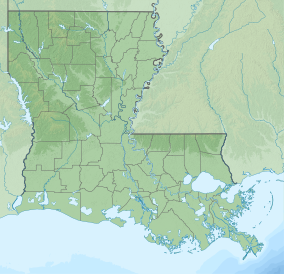
Back Poverty Point Catalan Poverty Point National Monument CEB Poverty Point Czech Poverty Point German Poverty Point Spanish پاورتی پوینت Persian Poverty Point Finnish Poverty Point French פוברטי פוינט HE Poverty Point Croatian
| Poverty Point National Monument | |
|---|---|
 A map of the Poverty Point site | |
| Location | West Carroll Parish, Louisiana, U.S. |
| Nearest city | Epps, Louisiana |
| Coordinates | 32°38′12″N 91°24′41″W / 32.63667°N 91.41139°W |
| Area | 910.85 acres (368.61 ha)[1] |
| Authorized | October 31, 1988 |
| Governing body | Louisiana Office of State Parks |
| Website | Poverty Point National Monument |
| Official name | Monumental Earthworks of Poverty Point |
| Type | Cultural |
| Criteria | iii |
| Designated | 2014 (38th session) |
| Reference no. | 1435 |
| Region | Europe and North America |

Poverty Point State Historic Site/Poverty Point National Monument (French: Pointe de Pauvreté; 16 WC 5) is a prehistoric earthwork constructed by the Poverty Point culture, located in present-day northeastern Louisiana. Evidence of the Poverty Point culture extends throughout much of the Southeastern Woodlands of the Southern United States. The culture extended 100 miles (160 km) across the Mississippi Delta and south to the Gulf Coast.
The Poverty Point site has been designated as a state historic site, U.S. National Monument, a U.S. National Historic Landmark, and UNESCO World Heritage Site.[2] The site is 15.5 miles (24.9 km) from the current flow of the Mississippi River,[3] and is situated on the edge of Macon Ridge. The village of Epps developed in the historic period in West Carroll Parish, Louisiana.
The Poverty Point site contains earthen ridges and mounds, built by indigenous people between 1700 and 1100 BCE during the Late Archaic period in North America.[4] Archaeologists have proposed a variety of possible functions for the site, including as a settlement, a trading center, and/or a ceremonial religious complex.
The 402-acre (163 ha) property now operated as the Poverty Point State Historic Site[5] contains "the largest and most complex Late Archaic earthwork occupation and ceremonial site yet found in North America".[6] Euroamericans described the site in the 19th century. Since the 1950s Poverty Point has been the focus of professional archaeological excavations. The earthworks are named after a 19th-century plantation on the property.
- ^ "Listing of acreage – December 31, 2011" (XLSX). Land Resource Division, National Park Service. Retrieved May 14, 2012. (National Park Service Acreage Reports)
- ^ Greg Hilburn. "A first for Louisiana: Poverty Point selected as World Heritage site". Monroe News-Star. Archived from the original on June 22, 2014. Retrieved June 23, 2014.
- ^ Milner, George R. (2004). The Moundbuilders: Ancient Peoples of Eastern North America. London: Thames & Hudson Ltd.
- ^ U.S. Department of the Interior (2013). The Monumental Earthworks of Poverty Point (PDF). Nomination to the World Heritage List by the United States of America. p. 106.
- ^ U.S. Department of the Interior (2013). Monumental Earthworks of Poverty Point. Nomination to the World Heritage List by the United States of America. p. 106.
- ^ "Poverty Point" Archived 2015-04-29 at the Wayback Machine, National Historic Landmarks Program, National Park Service

